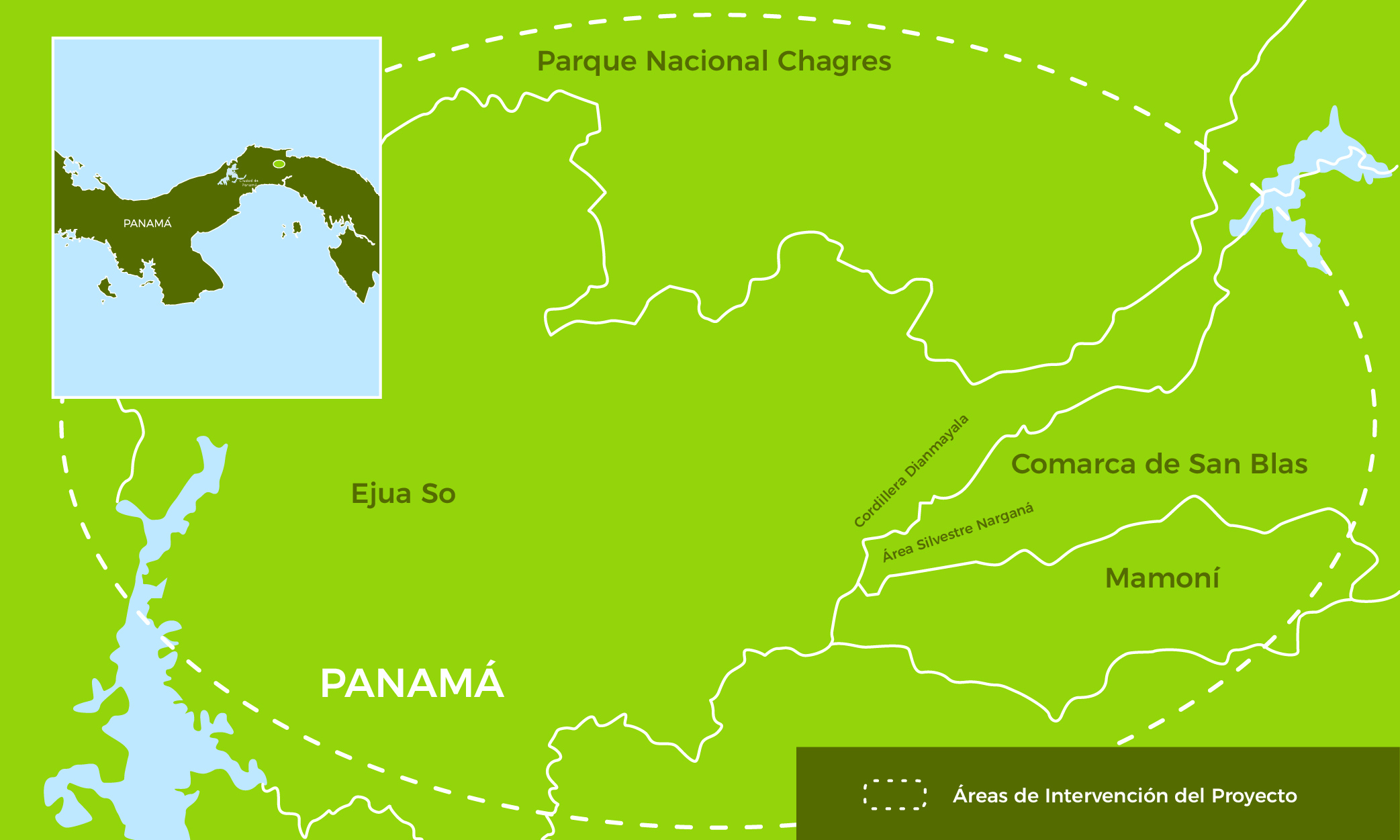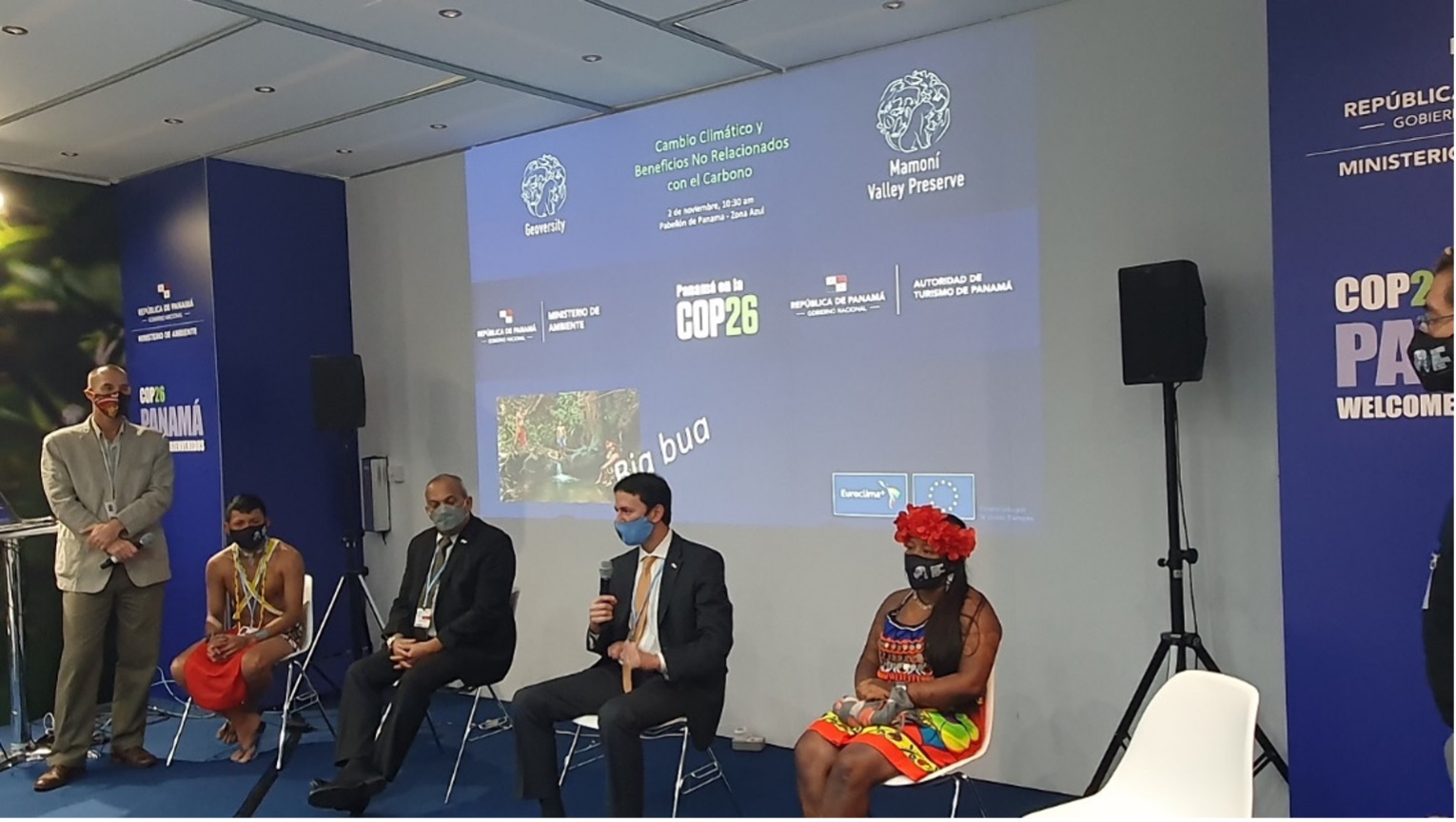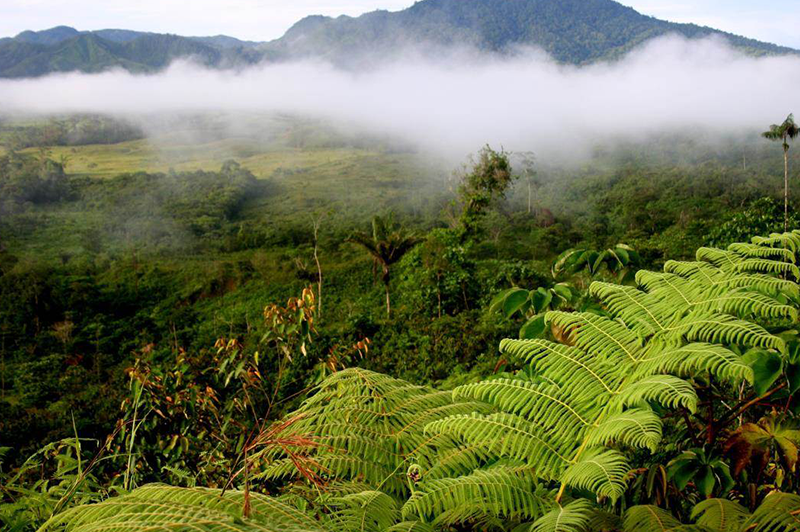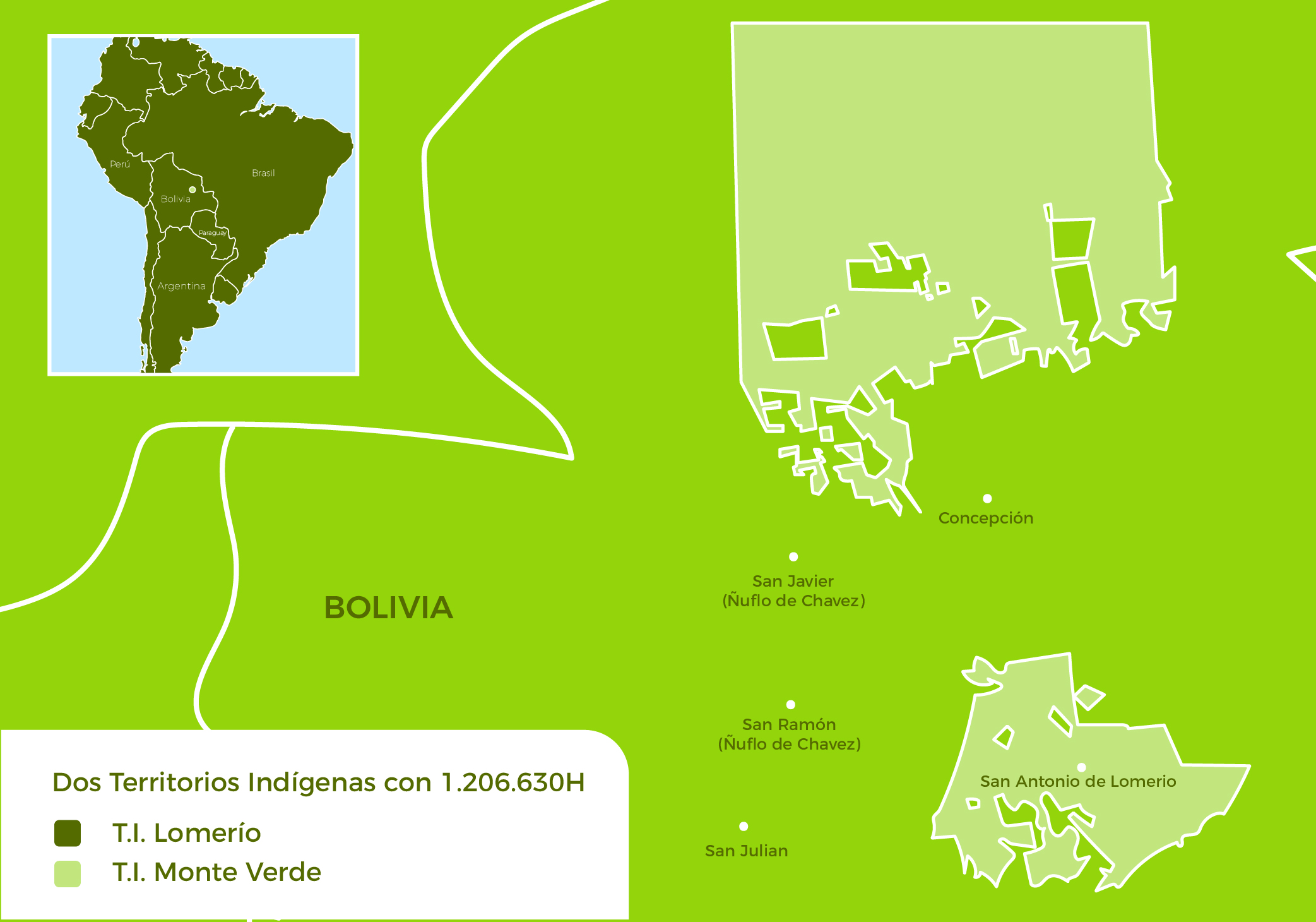The Non Carbon-Related Benefits Project (BNRC) has enabled diverse indigenous groups in both countries to protect their natural resources, develop beekeeping activities, access water, and implement initiatives to improve community governance.
8 May, 2023. The Intergovernmental Panel on Climate Change (IPCC) concluded in its report on Climate Change and the Earth (2019) that the conservation of carbon-rich ecosystems, such as forests, represents one of the few response options with immediate impacts on climate change mitigation and adaptation.
In the document, the IPCC recommends the participation of communities for effective decision-making and governance, as well as the inclusion of indigenous knowledge. Such participation requires recognition of the benefits that local communities receive from activities that contribute to climate change mitigation and adaptation, beyond carbon sequestration. In that regard, Non-Carbon-Related Benefits (BNRC) is a concept that allows for the identification of benefits, focusing on socio-economic, environmental, biocultural and governance aspects.
"Article 5 of the Paris Agreement (PA) invites countries to strengthen and implement GHG reductions with some ambition but seeking to compensate based on verifiable results. The BNRC concept has a broader range of elements for sustainable forest management that we have sought to strengthen," says Edwin Camacho, general coordinator of the Forests of the World project.
Derived from the above considerations, the EUROCLIMA+ project, "Non Carbon-Related Benefits", developed by Forests of the World together with the Geoversity Foundation in Panama; and Support for Farming-Indigenous People in Eastern Bolivia (APCOB) in Bolivia, was designed. The latter has made progress on the institutionalisation of BNRCs in indigenous communities in Bolivia and Panama, and on climate change mitigation and adaptation strategies.
|
|
 |
Learn more about the BNRC concept, bioculture and the contributions of the project in this video:
In Panama, the project has been implemented by the Geoversity Foundation, the indigenous organisation Emberá Ẽjuä So and the farming communities Mamoní Arriba, la Zahina, el Valle and San José, located in the upper basin of the Mamoní River in the Madroño Valley. Through this project, the conservation of the Mamoní Valley Reserve is promoted. This covers 40% of the upper basin, and since its creation in 2006, it has increased its forest cover by 9.8%.
This area is of great importance due to its high biodiversity and the livelihoods it provides to communities. However, its ecological integrity is at risk. Within the Valley, the Tumbes - Chocó - Magdalena ecoregion is considered one of the 10 most threatened ecological hotspots on the planet.
In this context, the Geoversity Foundation manages the Reserve under the BNRC concept with the intention that "the plants, people and animals coexist in harmony".
For the Geoversity Foundation, it is crucial that the communities are the ones who prioritise and develop BNRC initiatives in the Reserve. Therefore, they have applied a methodological approach through which representatives of the Emberá Ejuä So[1] territory and farmer communities prioritise the most relevant activities for their groups. In this case, the representatives of the Emberá territory have prioritised water conservation and supply, while the farmer communities were oriented towards the improvement of their governance.
The BNRC and water in the Emberá territory
As part of the implementation of the project in Panama, a pilot project was developed in the Embera Ẽjuä So territory, inhabited predominantly by the Embera ethnic group, and to a lesser extent by the Wounaan ethnic group. It is located in the Panama Canal watershed, which occupies about 90% of the Chagres National Park, which is part of the National System of Protected Areas under the Ministry of Environment, and provides half of the water for the Panama Canal, and all the drinking water for the capital city and surrounding areas. Water from Embera and Wounaan lands contributes directly to the supply of drinking water in Panama City, West Panama, Colon and the Canal to sustain economic growth and key activities such as agriculture, energy production, transport and tourism.
It is important to highlight that, for the Embera, the location of freshwater sources is important when deciding where to settle and how to use the land.
In turn, the maintenance of forests in the Embera Ẽjuä So territory is crucial for water regulation and quality. Forests help ensure a naturally regulated water yield and contribute to the health of aquatic ecosystems and, in turn, provide ecosystem services. Water is essential for the sustenance and reproduction of life in the forest and the circulation of nutrients, being an indispensable factor for the development of biological processes.
Water also has a spiritual significance for the Emberá people. According to a myth, water connects directly with the forest. From their creator, the Emberá people were charged with taking care of the marshes and rivers, to ensure the benefit for all. The transfer of ancestral knowledge from the wise men to the youth means that the culture and the relationship to the territory and resources is maintained, forming new leaders.
The communities in which water-related activities were developed within the framework of the project were Emberá Puru, La Bonga, Emberá Drua, Puru Biakiru, Parara Puru, Tusípono, Ella Drua and Ella Puru. The economy of these populations is 95% based on cultural tourism, given that they are restricted from having a traditional lifestyle, as they are located in the Chagres National Park.
Through a 3-day workshop in the Parara Puru community developed in October 2021, in which 9 traditional authorities and 15 community members (9 young people and 6 women) participated, the following activities related to the BNRCs were prioritised:
- Socio-economic: Adaptation of eight community aqueducts with permanent drinking water in the Embera and Wounaan communities. In addition, a micro-plant for the production, bottling and commercialisation of water was created.
- Biocultural: Research on traditional knowledge about water together with the most knowledgeable people (elders) of the Embera communities.
- Environmental: Preservation of Dianmayala hill and its surroundings.
The process was realised through the collection of information and knowledge on the importance of water for young people, women and authorities, an activity that was facilitated by Geoversity.
Through the activities related to BNRCs, climate change mitigation is contributed to, as they all involve the valuation and preservation of forests as culturally important actors and providers of hydrological ecosystem services.
Community governance in the rural communities of the Mamoní valley
The four farming communities with whom the project worked were Mamoní Arriba, La Zahina, El Valle and San José, located in Panama. These communities had a poorly defined decision-making system, and until the arrival of the project they had no system of coordination between their communities.
The four communities initially prioritised clean water and livelihood opportunities (ecotourism and sustainable aquaculture). However, they realised that they were not ready to implement activities without first significantly improving their community organisation. Therefore, the communities chose to link their priorities to governance as a prior requirement for the design and sustainable implementation of BNRC activities.
At the governance level, the pilot project produced tangible results for the communities:
- New community structures, including in the process of formalisation before public institutions, and with internal rules for decision-making.
- Closer links with state and conservation institutions to further develop BNRC initiatives, such as the Ministry of Environment and the Panamanian Tourism Authority.
The pilot project left a very important methodological and conceptual lesson learned: many mestizo/farmer communities do not have the required prior institutional governance capacity to participate in processes with a collective effect and global impact related to climate change. In this regard, the previous existence of a governance structure is fundamental and must be analysed before initiating a process related to the identification of actions associated with BNRCs.
Institutionalisation and scaling up of BNRCs in Panama
Due to its conceptual importance, the project promoted the institutionalisation of BNRCs in climate policies. To this end, agreements were sought with national and international actors, so that they could position the concept, and promote the importance of Monitoring, Reporting and Verification systems for their follow-up.
The project was invited by the Ministry of Environment and the Ministry of Tourism of Panama to hold a session during COP26 in Glasgow in 2021. The Geoversity Foundation participated in the session, as well as Emberá and Wounaan indigenous youth.
One of the main outcomes during COP26 was to institutionalise the concept of BNRCs in the framework of the projects implemented by the Independent Association of Latin America and the Caribbean (AILAC). The project and AILAC agreed that the characteristics of BNRCs would be used as part of the eligibility criteria for the financing of projects funded by the Association..
 |
| Presentation on BNRCs at COP26 with Emberá and Wounaan indigenous youth and guests of the Panamanian Ministers of Environment and Tourism. |
The next steps for BNRCs
In September 2021, Forests of the World and the Geoversity Foundation obtained approval for the continuation of the EUROCLIMA+ project under the title "Territorial defence of indigenous lands, tropical forest and civic space threatened by the COVID-19 pandemic in Panama", funded by the Government of Denmark. It is implemented in the same two territories in Panama (Embera/Wounaan and Mamoní), with the same beneficiary communities and adds a third indigenous territory as beneficiary: Gunayala.
The project aims to:
- Reclaim civic space to restore social, environmental and cultural justice in the Emberá/Wounaan and Guna indigenous forest territories, and in the Mamoní Valley Reserve, all located around the Dianmayala mountain range and threatened by a new law promoting industrial-scale agricultural development, approved in the COVID-19 context, as well as accelerating unattended encroachment and illegal resource extraction.
- Develop capacities and alliances to strengthen civil society and indigenous peoples in 13 communities in two indigenous territories, as well as mestizos in the Mamoní Valley Reserve, to demand their rights, restore justice and protect their environment.
In addition, another complementary project was approved: "Strengthening indigenous-led management and inter-institutional cooperation in Gunayala and the Mamoni Valley". This will be funded through Re:wild, and will benefit communities in the Mamoni and Gunayala territories. The project aims to mitigate threats to their lands and cultures through the development of an effective community patrol system, while improving relations with national authorities and other key actors.
With these two projects, the participating communities continue to benefit directly from the experiences and their new governance and communication capacities, aiming for a territorially broadened climate impact.
“We believe that the Dianmayala initiative has the potential to become one of the most significant and successful conservation efforts in the 'Big Five Forests' of Central America". Christopher Jordan of Re:wild.
Bolivian women implement BNRCs through bee keeping
In Bolivia, the project was implemented in the indigenous territories of Monte Verde and Lomerío in the department of Santa Cruz, where a group of women were involved in the implementation of practical actions for the use and conservation of the BNRCs that have allowed:
- Creation of a communal protected area called "Reserva Ecológica y Manejo Integral -El Rancho", which allows the protection of the copaibo tree, a species used by Chiquitano families for medicinal purposes because of its antibiotic properties and as a pain reliever for rheumatic pain. The sale of copaiba oil and its derivatives currently represents a source of income for 25 families.
- Implementation of beekeeping, an activity that complements agroforestry systems and increases coffee fruit yields. 50 families in the communities of El Rancho, San Pablo and Río Blanco benefit from the production of honey and the trade of native species with honey-producing potential.
- Breeding of native bees in sustainable systems, which have nutritional and medicinal properties and also present enormous benefits in forest restoration. This activity has enabled the support of 60 families in Monte Verde and Lomerío, who are now improving their income, food, political and social position in their communities through the sale of honey, pollen and their derivatives.
Through meliponiculture (breeding and management of bees), BNRCs have been recognised and protected because this allows for the conservation and rescue of ancestral knowledge about the diversity of native bees. For example, the use of honey, pollen and resins collected by bees is recognised. The methods of honey extraction, the places where the bees live, and the floral species they feed on and pollinate are also known. In this way, the Chiquitano population benefits from, values, and at the same time contributes to conserving the ecosystem services of water and the biodiversity of the forests in which they live"Without the existence of bees, everything is lost. You can't recover a burnt part of the forest because there is no one to bring pollen for the surviving plants to bear fruit and seeds. It's like in other countries where there are no more bees, people harvest pollen to pollinate, and that costs more work and money. Here you just have to wait for the bees to do their job and then restoration is easier. Every little animal has its own job.”
Mónica Guasasede (25 years old) of the community of San Lorenzo. - Extraction of essential oils from native plants such as vira vira, camphor, matricaria nuvataxhu, lemon balm, masiare, ocorocillo, paja carona, among others, in the community of Todos Santos in Lomerío. This biocultural activity, in which men and women from 25 families in the community participate, is based on traditional knowledge of the uses of native species. Once the plants have been prioritised, scientific knowledge is used to extract the oils, which are then sold to improve their income.
Incorporation of BNRCs into the Departmental Climate Change Strategy in Santa Cruz de la Sierra
The socialisation events on the concept and values of the BNRCs disseminated by the project attracted the attention of regional and local authorities in the department of Santa Cruz de la Sierra.
The five indigenous peoples of the Department of Santa Cruz de la Sierra met at COP26 in Glasgow. The pilot experiences were presented by the leaders of the indigenous Chiquitano communities that implemented them, and the regional and national forums were presented, as well as the dissemination campaigns led by young activists.
These activities aroused the interest and commitment of the government of the department of Santa Cruz, which included the BNRCs in the Departmental Climate Change Strategy of the Department. The Strategy aims to guide all departmental actors to minimise the potential costs and risks associated with climate change, and to take advantage of the opportunities for a resilient Santa Cruz towards 2030, 2040 and 2050.
“The BNRC concept is fundamentally a climate change mitigation mechanism based on community priorities, as mandated by the Paris Agreement. We believe that our practical approach to governance and bioculturality is key to engaging all societies to ensure the economic and mental transformation needed to avert global catastrophe". Claus Kjaerby, director of the project in Panama, Geoversity.
-
Articles published about the project
- Virtual Conversation Series: The Goodness of the Forest and what are we doing for it? Link
- Meeting between projects and new authorities of the Plurinational State of Bolivia. Link
Documents and publications
- Report: Defining the Non-Carbon Related Benefits. Link
DATA:
- The Non-Carbon Related Benefits project is part of the "Forests, Biodiversity and Ecosystems" sector of the EUROCLIMA+ programme, implemented by the agencies Expertise France (EF) and the German Society for International Cooperation (GIZ) GmbH. Learn more here.
- The project has been developed together with its partners Bosques del Mundo, Geoversity, Support to Indigenous Farmers of Eastern Bolivia (APCOB), and the Forest Stewardship Council International Center.
About EUROCLIMA+
EUROCLIMA+ is a programme funded by the European Union and co-financed by the German Federal Government through the Federal Ministry for Economic Cooperation and Development (BMZ), as well as by the governments of France and Spain. Its objective is to reduce the impact of climate change and its effects in 18 Latin American and Caribbean countries by promoting climate change mitigation and adaptation, resilience and investment. The Programme is implemented under the synergistic work of seven agencies: the Spanish Agency for International Development Cooperation (AECID), the French Development Agency (AFD), the Economic Commission for Latin America and the Caribbean (ECLAC), Expertise France (EF), the International and Ibero-America Foundation for Administration and Public Policy (FIIAPP), the German Society for International Cooperation (GIZ) GmbH, and the UN Environment Programme..
Contact for more information: This email address is being protected from spambots. You need JavaScript enabled to view it.
[1] The Emerbá Ejuä So Territory is composed of three territories, eight communities. Each community has an independent titling process, but they work collectively in a single representative structure: the Regional Congress of the Emberá and Wounaan Communities of the Panama Canal Watershed.


